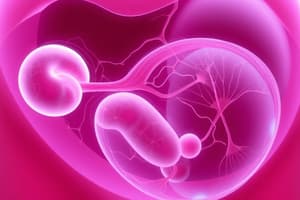Podcast
Questions and Answers
What is the primary function of the testes in the male reproductive system?
What is the primary function of the testes in the male reproductive system?
- To produce sperm through meiosis (correct)
- To transport sperm to the ovum
- To support the urinary system
- To produce testosterone
In which structure do sperm mature before fertilization occurs?
In which structure do sperm mature before fertilization occurs?
- Seminal vesicles
- Prostate gland
- Vas deferens
- Epididymis (correct)
What is the role of the seminal vesicles in the male reproductive system?
What is the role of the seminal vesicles in the male reproductive system?
- To regulate hormone levels
- To produce sperm cells
- To provide nutrients for sperm (correct)
- To store urine
Which duct structure is NOT part of the pathway sperm travels through after being produced?
Which duct structure is NOT part of the pathway sperm travels through after being produced?
Why are the testes located in the scrotum?
Why are the testes located in the scrotum?
What is the primary role of the prostate gland in the male reproductive system?
What is the primary role of the prostate gland in the male reproductive system?
Which structure is responsible for regulating the temperature of the testes?
Which structure is responsible for regulating the temperature of the testes?
What does the bulbourethral gland produce?
What does the bulbourethral gland produce?
Which part of the male reproductive system is a dual-purpose duct?
Which part of the male reproductive system is a dual-purpose duct?
What is the function of the seminal vesicles in the male reproductive system?
What is the function of the seminal vesicles in the male reproductive system?
Flashcards are hidden until you start studying
Study Notes
Seed Germination
- Germination occurs under favorable conditions.
- A new plantlet develops from the zygote using food stored in the endosperm.
Human Reproduction
- Human reproduction is primarily sexual, involving the fusion of male and female gametes.
Hormones in Human Reproduction
- Hormones play a critical role in controlling human reproductive function.
- These hormones are responsible for changes that occur during sexual maturity.
Minimum Age for Marriage
- The Indian government mandates a minimum age for marriage at 18 for girls and 21 for boys likely due to factors like:
- Physical and mental maturity
- Social and economic considerations
- Ensuring well-being of the individuals and offspring.
Human Male Reproductive System
- The male reproductive system consists of testes, various ducts, and glands.
- Testes are located outside the abdominal cavity in the scrotum.
- Seminiferous tubules within the testes house germinal epithelium, responsible for sperm production through meiosis.
- Sperm travels through a series of ducts:
- Rete testis
- Vas efferens
- Epididymis
- Vas deferens
- Ejaculatory duct
- Urinogenital duct
- Sperm maturation occurs within these ducts before fertilization.
Male Reproductive Organs:
- Testes: Produce sperm and testosterone.
- Seminal vesicles: Contribute fluids to semen.
- Prostate gland: Secretes fluids to aid in sperm motility and survival.
- Cowper's gland: Secretes a clear fluid before ejaculation to neutralize any residual acidic urine in the urethra.
- Vas deferens: Tube that transports sperm from epididymis to the ejaculatory duct.
- Epididymis: Site of sperm maturation and storage.
- Urinary bladder: Stores urine.
- Ejaculatory duct: Conducts sperm and seminal fluid to the urethra.
- Penis: Erectile organ responsible for sperm delivery.
- Scrotum: Sac that houses the testes and regulates their temperature.
Male Reproductive Organs
- The testes produce both sperm and hormones, namely testosterone.
- The scrotum is a pouch of skin that houses the testes and functions to regulate testicular temperature for optimal sperm production.
- The epididymis is a coiled tube connected to the testes that facilitates sperm maturation and temporary storage.
- The vas deferens is a muscular tube that transports sperm from the epididymis to the ejaculatory duct, passing by the urinary bladder.
- Seminal vesicles are glands that contribute fructose-rich seminal fluid to nourish and aid in sperm transport.
- The prostate gland secretes a fluid that nourishes and protects sperm, and also helps liquefy semen after ejaculation.
- Bulbourethral glands (Cowper's Glands) produce a pre-ejaculatory fluid which lubricates the urethra and neutralizes any acidity.
- The urethra is a dual-purpose duct that carries both urine from the bladder and semen from the reproductive tract, extending from the bladder to the external urethral orifice.
- The penis is an external organ responsible for sexual intercourse and urination, containing erectile tissue that engorges with blood to achieve an erection.
- The foreskin, or prepuce, is a fold of skin covering the glans (tip) of the penis, which can be removed through circumcision.
Studying That Suits You
Use AI to generate personalized quizzes and flashcards to suit your learning preferences.




